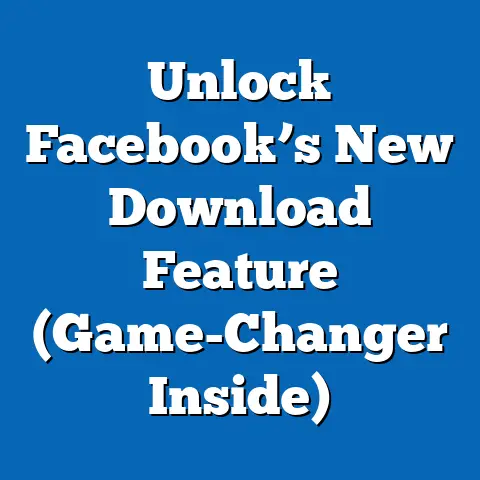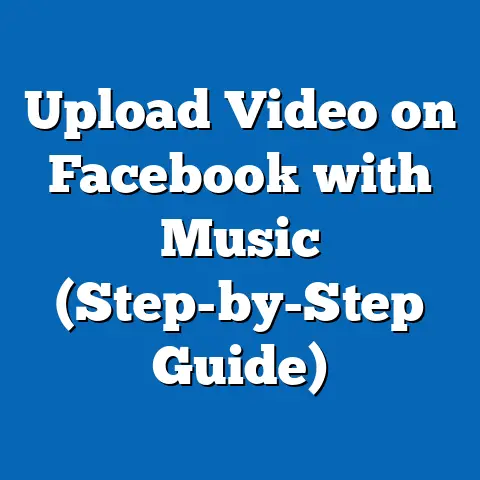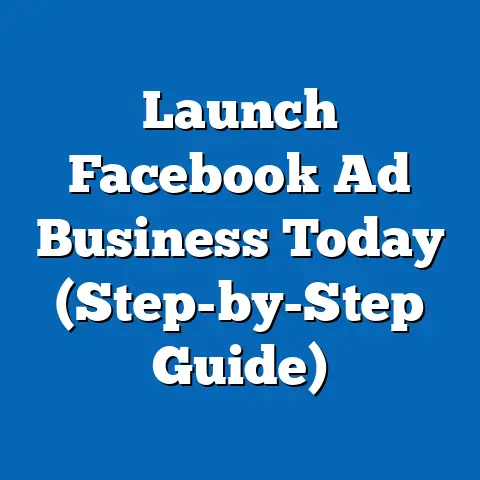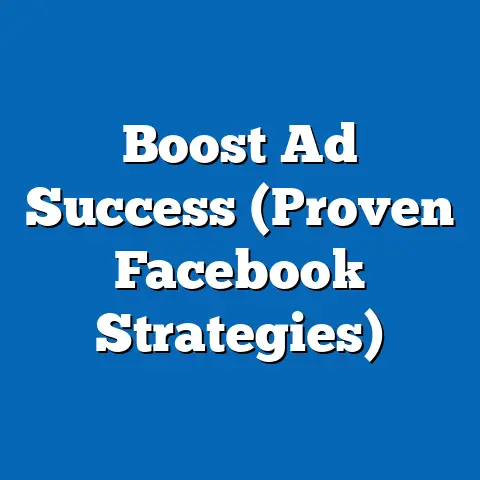Craft Eye-Catching Facebook Image Ads (Ultimate Guide)
In a world overflowing with visual content, the simplest images often capture the most attention. Think about it: you’re scrolling through your Facebook feed, a seemingly endless stream of posts, videos, and ads vying for your attention. The challenge for businesses and marketers today isn’t just about creating content, it’s about creating content that cuts through the noise. With the sheer volume of images bombarding users daily, standing out on Facebook requires a strategic approach to visual advertising.
Facebook image ads, when done right, are a powerful tool to connect with your target audience, drive engagement, and ultimately, boost conversions. However, a poorly designed or irrelevant image ad can easily get lost in the shuffle, becoming just another forgotten piece of content.
I’ve spent years experimenting with Facebook ads, analyzing what works and what doesn’t. I’ve seen firsthand how a well-crafted image ad can significantly impact campaign performance. I remember working with a local bakery that was struggling to attract new customers. We revamped their Facebook ads, focusing on high-quality images of their freshly baked goods. The result? A 30% increase in foot traffic within a month!
This guide is designed to equip you with the knowledge and tools you need to create Facebook image ads that not only grab attention but also drive results. We’ll cover everything from understanding the different types of image ads to mastering visual design principles and optimizing your campaigns for maximum impact. Get ready to transform your Facebook advertising strategy!
1. Understanding Facebook Image Ads
Facebook image ads are exactly what they sound like: advertisements that primarily use an image to convey a message and attract attention on the Facebook platform. They are a foundational element of many Facebook marketing strategies, and for good reason. They offer a direct and visually appealing way to communicate with potential customers.
Within the Facebook advertising ecosystem, you’ll find several types of image ads, each with its own strengths and use cases:
- Single Image Ads: This is the most basic and widely used type. It features a single image accompanied by ad copy and a call-to-action button. They’re great for showcasing a product, service, or brand message in a simple, impactful way.
- Carousel Ads: Carousel ads allow you to display multiple images or videos (up to 10) within a single ad unit. Each image can have its own headline, description, and link, making them ideal for showcasing different features of a product, telling a story, or highlighting multiple products in a catalog.
- Collection Ads: Primarily used for e-commerce, collection ads feature a hero image or video at the top, followed by a selection of related products displayed below. This format provides a seamless shopping experience for users.
- Instant Experience Ads: Formerly known as Canvas ads, Instant Experience ads open into a full-screen, mobile-optimized experience when a user clicks on the ad. They can incorporate images, videos, text, and interactive elements to create a more immersive and engaging experience.
Why Image Ads Matter:
Image ads are crucial for driving engagement and conversions because they leverage the power of visual communication. Here are some key statistics to consider:
- Posts with images get 2.3X more engagement than those without (BuzzSumo).
- Visual content is 40X more likely to get shared on social media than other types of content (HubSpot).
- People remember 80% of what they see versus 20% of what they read (Zabisco).
These statistics highlight the importance of visual content in capturing attention and driving action on social media. Image ads capitalize on this by presenting your message in a visually appealing format that resonates with your target audience.
Image Ads vs. Other Ad Formats:
While Facebook offers various ad formats, including video ads, text ads, and lead generation ads, image ads offer a unique combination of simplicity and impact. Here’s a quick comparison:
- Image Ads vs. Video Ads: Video ads can be highly engaging, but they require more resources to produce and may not be suitable for all businesses. Image ads are easier and more cost-effective to create, making them a great option for businesses with limited budgets or resources.
- Image Ads vs. Text Ads: Text ads rely solely on written copy to convey a message. In a visually driven platform like Facebook, image ads are far more likely to capture attention and stand out from the crowd.
- Image Ads vs. Lead Generation Ads: Lead generation ads are designed to collect leads directly within the Facebook platform. While effective for lead generation, they may not be as versatile as image ads for driving brand awareness, website traffic, or sales.
Takeaway: Understanding the different types of image ads and their strengths is the first step in creating effective Facebook advertising campaigns. Choose the format that best aligns with your goals and target audience.
2. Key Elements of Eye-Catching Image Ads
Now that we’ve established the importance of image ads, let’s dive into the key elements that make them truly eye-catching. Creating a visually appealing ad isn’t just about slapping an image onto Facebook; it’s about carefully considering each component and how they work together to create a cohesive and compelling message.
Here are the fundamental components of an effective image ad:
- Visual Appeal: This is the foundation of any successful image ad. Your image needs to be visually appealing and grab attention within seconds.
- Color: Use colors that are consistent with your brand and that stand out in the Facebook news feed. Consider using contrasting colors to draw the eye to key elements.
- Composition: Pay attention to the composition of your image. Use the rule of thirds, leading lines, and other design principles to create a visually balanced and engaging image.
- Imagery: Choose high-quality images that are relevant to your target audience and your brand. Avoid using generic stock photos that look staged or inauthentic.
- Branding: Maintaining brand consistency is crucial for building brand recognition and trust.
- Logo: Incorporate your logo into your image ad in a subtle yet visible way. Avoid making it too large or distracting.
- Brand Colors: Use your brand colors in your image ad to reinforce your brand identity.
- Brand Voice: Ensure that your ad copy and visuals align with your overall brand voice and messaging.
- Text Overlays: Text overlays can be used to highlight key information, such as discounts, promotions, or product features.
- Font Choices: Choose fonts that are easy to read and that complement your brand aesthetic. Avoid using too many different fonts in a single ad.
- Readability: Ensure that your text is legible and easy to read on both desktop and mobile devices. Use sufficient contrast between your text and background.
- Message Clarity: Keep your message concise and to the point. Avoid using jargon or overly technical language.
- Call to Action (CTA): A clear and compelling CTA is essential for driving conversions.
- Placement: Place your CTA in a prominent location where it’s easy for users to see and click.
- Wording: Use action-oriented language that encourages users to take the desired action. Examples include “Shop Now,” “Learn More,” “Sign Up,” and “Get Started.”
- Relevance: Ensure that your CTA is relevant to your ad copy and visuals.
- Color: Use colors that are consistent with your brand and that stand out in the Facebook news feed. Consider using contrasting colors to draw the eye to key elements.
- Composition: Pay attention to the composition of your image. Use the rule of thirds, leading lines, and other design principles to create a visually balanced and engaging image.
- Imagery: Choose high-quality images that are relevant to your target audience and your brand. Avoid using generic stock photos that look staged or inauthentic.
- Logo: Incorporate your logo into your image ad in a subtle yet visible way. Avoid making it too large or distracting.
- Brand Colors: Use your brand colors in your image ad to reinforce your brand identity.
- Brand Voice: Ensure that your ad copy and visuals align with your overall brand voice and messaging.
- Font Choices: Choose fonts that are easy to read and that complement your brand aesthetic. Avoid using too many different fonts in a single ad.
- Readability: Ensure that your text is legible and easy to read on both desktop and mobile devices. Use sufficient contrast between your text and background.
- Message Clarity: Keep your message concise and to the point. Avoid using jargon or overly technical language.
- Placement: Place your CTA in a prominent location where it’s easy for users to see and click.
- Wording: Use action-oriented language that encourages users to take the desired action. Examples include “Shop Now,” “Learn More,” “Sign Up,” and “Get Started.”
- Relevance: Ensure that your CTA is relevant to your ad copy and visuals.
My Experience with Text Overlays:
I’ve learned that the amount of text you use on your image can make or break your ad. Facebook used to have a strict “20% text rule,” penalizing ads with too much text. While that rule is no longer in effect, the principle still holds true: less is often more. Overcrowding your image with text can make it look cluttered and unprofessional, deterring users from engaging with your ad. Focus on conveying your message concisely and visually.
Takeaway: Each element of your image ad plays a crucial role in capturing attention and driving conversions. By carefully considering the visual appeal, branding, text overlays, and call to action, you can create ads that resonate with your target audience and achieve your marketing goals.
3. Creating Compelling Visuals
Now, let’s get practical. How do you actually create compelling visuals for your Facebook image ads? Whether you’re a seasoned designer or a complete beginner, there are several strategies and tools you can use to create stunning visuals that capture attention and drive results.
- Sourcing High-Quality Images: The first step is to find or create high-quality images that are relevant to your brand and target audience.
- Stock Photos: Stock photos can be a cost-effective option for sourcing images, but it’s important to choose them carefully. Avoid using generic stock photos that look staged or inauthentic. Look for images that are visually appealing, relevant to your message, and that feature diverse models and settings.
- Original Photography: If you have the budget and resources, consider investing in original photography. This allows you to create unique and authentic visuals that truly represent your brand. Hire a professional photographer to capture high-quality images of your products, services, or team.
- User-Generated Content (UGC): User-generated content can be a powerful way to build trust and credibility with your audience. Encourage customers to share photos of themselves using your products or services, and feature these images in your ads.
- Design Tools and Software: Once you have your images, you can use design tools and software to enhance them and create visually appealing ads.
- Canva: Canva is a user-friendly design tool that’s perfect for creating Facebook image ads. It offers a wide range of templates, graphics, and fonts, making it easy to create professional-looking ads even if you have no design experience.
- Adobe Photoshop: Photoshop is a more advanced design tool that offers a wider range of features and capabilities. It’s ideal for creating complex designs, editing photos, and creating custom graphics.
- Adobe Illustrator: Illustrator is a vector-based design tool that’s perfect for creating logos, icons, and other graphics that need to be scaled without losing quality.
- A/B Testing Images: The best way to determine what resonates best with your audience is to A/B test different images.
- Create Multiple Versions: Create multiple versions of your image ad with different images, colors, text overlays, and CTAs.
- Run A/B Tests: Use Facebook’s A/B testing feature to run your ads and see which versions perform best.
- Analyze Results: Analyze the results of your A/B tests and use the data to optimize your ads for maximum impact.
- Stock Photos: Stock photos can be a cost-effective option for sourcing images, but it’s important to choose them carefully. Avoid using generic stock photos that look staged or inauthentic. Look for images that are visually appealing, relevant to your message, and that feature diverse models and settings.
- Original Photography: If you have the budget and resources, consider investing in original photography. This allows you to create unique and authentic visuals that truly represent your brand. Hire a professional photographer to capture high-quality images of your products, services, or team.
- User-Generated Content (UGC): User-generated content can be a powerful way to build trust and credibility with your audience. Encourage customers to share photos of themselves using your products or services, and feature these images in your ads.
- Canva: Canva is a user-friendly design tool that’s perfect for creating Facebook image ads. It offers a wide range of templates, graphics, and fonts, making it easy to create professional-looking ads even if you have no design experience.
- Adobe Photoshop: Photoshop is a more advanced design tool that offers a wider range of features and capabilities. It’s ideal for creating complex designs, editing photos, and creating custom graphics.
- Adobe Illustrator: Illustrator is a vector-based design tool that’s perfect for creating logos, icons, and other graphics that need to be scaled without losing quality.
- Create Multiple Versions: Create multiple versions of your image ad with different images, colors, text overlays, and CTAs.
- Run A/B Tests: Use Facebook’s A/B testing feature to run your ads and see which versions perform best.
- Analyze Results: Analyze the results of your A/B tests and use the data to optimize your ads for maximum impact.
Examples of Successful Facebook Image Ads:
To illustrate effective visual strategies, let’s look at some examples of successful Facebook image ads from various industries:
- Fashion: A clothing retailer uses a high-quality image of a model wearing their latest collection. The image is visually appealing, showcases the product effectively, and includes a clear CTA to “Shop Now.”
- Food: A restaurant uses a mouthwatering image of their signature dish. The image is well-lit, features vibrant colors, and includes a text overlay highlighting a special promotion.
- Travel: A travel agency uses a stunning landscape photo to promote a vacation package. The image is visually captivating, evokes a sense of wanderlust, and includes a CTA to “Learn More.”
My Personal Experience with Visuals:
I once worked with a client who was selling handmade jewelry. Their initial Facebook ads featured poorly lit, unedited photos of their products. The ads were getting very little engagement. We invested in professional product photography and created ads that showcased the jewelry in a beautiful and appealing way. The result was a dramatic increase in sales and website traffic.
Takeaway: Creating compelling visuals is essential for capturing attention and driving results with Facebook image ads. By sourcing high-quality images, using design tools effectively, and A/B testing different options, you can create ads that resonate with your target audience and achieve your marketing goals.
4. Targeting and Optimization
Creating visually appealing image ads is only half the battle. To truly succeed with Facebook advertising, you need to target the right audience and optimize your campaigns for maximum impact.
- Identifying Your Target Audience: The first step is to identify and understand your target audience.
- Demographics: Consider the age, gender, location, education level, and income of your ideal customer.
- Interests: What are your target audience’s interests, hobbies, and passions? What pages do they like on Facebook? What groups do they belong to?
- Behaviors: What are your target audience’s online behaviors? What websites do they visit? What apps do they use? What purchases do they make online?
- Facebook’s Targeting Options: Facebook offers a wide range of targeting options that allow you to reach your ideal customer.
- Core Audiences: Core Audiences allow you to target users based on demographics, interests, and behaviors.
- Custom Audiences: Custom Audiences allow you to target users based on your own data, such as email lists, website visitors, or app users.
- Lookalike Audiences: Lookalike Audiences allow you to target users who are similar to your existing customers. This can be a powerful way to reach new customers who are likely to be interested in your products or services.
- Monitoring Ad Performance: Once your ads are running, it’s important to monitor their performance and make data-driven adjustments.
- Key Metrics: Track key metrics such as reach, impressions, clicks, click-through rate (CTR), cost per click (CPC), and conversion rate.
- A/B Testing: Continue to A/B test different images, ad copy, and targeting options to optimize your ads for maximum impact.
- Facebook Analytics: Use Facebook Analytics to gain insights into how users are interacting with your ads and website.
- Demographics: Consider the age, gender, location, education level, and income of your ideal customer.
- Interests: What are your target audience’s interests, hobbies, and passions? What pages do they like on Facebook? What groups do they belong to?
- Behaviors: What are your target audience’s online behaviors? What websites do they visit? What apps do they use? What purchases do they make online?
- Core Audiences: Core Audiences allow you to target users based on demographics, interests, and behaviors.
- Custom Audiences: Custom Audiences allow you to target users based on your own data, such as email lists, website visitors, or app users.
- Lookalike Audiences: Lookalike Audiences allow you to target users who are similar to your existing customers. This can be a powerful way to reach new customers who are likely to be interested in your products or services.
- Key Metrics: Track key metrics such as reach, impressions, clicks, click-through rate (CTR), cost per click (CPC), and conversion rate.
- A/B Testing: Continue to A/B test different images, ad copy, and targeting options to optimize your ads for maximum impact.
- Facebook Analytics: Use Facebook Analytics to gain insights into how users are interacting with your ads and website.
My Experience with Targeting:
I’ve seen firsthand how crucial targeting is to the success of a Facebook ad campaign. I remember working with a local bookstore that was trying to promote their new children’s book. Initially, they were targeting a broad audience of Facebook users. The results were disappointing. We refined their targeting to focus on parents with young children who were interested in books and reading. The result was a significant increase in sales and website traffic.
Takeaway: Targeting the right audience and optimizing your campaigns are essential for maximizing the impact of your Facebook image ads. By carefully considering your target audience, using Facebook’s targeting options effectively, and monitoring your ad performance, you can create campaigns that deliver results.
5. Common Mistakes to Avoid When Creating Facebook Image Ads
Even with the best intentions, it’s easy to make mistakes when creating Facebook image ads. Here are some common pitfalls to avoid:
- Overcrowding Ads with Too Much Text or Imagery: As mentioned earlier, less is often more. Avoid overcrowding your ads with too much text or imagery. Keep your message concise and visually appealing.
- Ignoring Mobile Optimization: The majority of Facebook users access the platform on mobile devices. Make sure your images are optimized for mobile viewing. Use high-resolution images that look good on smaller screens.
- Failing to Test and Analyze Ad Performance Regularly: Don’t set it and forget it. Regularly test and analyze your ad performance to identify what’s working and what’s not. Use the data to optimize your ads for maximum impact.
- Using Irrelevant or Low-Quality Images: This is a surefire way to turn off potential customers. Use high-quality images that are relevant to your brand and target audience.
- Not Having a Clear Call to Action: Tell users what you want them to do. Include a clear and compelling call to action that encourages them to take the desired action.
- Ignoring Facebook’s Ad Policies: Make sure your ads comply with Facebook’s advertising policies. Violating these policies can result in your ads being disapproved or your account being suspended.
Learning from Mistakes:
I’ve made my fair share of mistakes in the world of Facebook advertising. One of the biggest lessons I’ve learned is the importance of continuous testing and optimization. Don’t be afraid to experiment with different images, ad copy, and targeting options. And don’t get discouraged if your initial ads don’t perform as well as you hoped. Use the data to learn and improve.
Takeaway: By avoiding these common mistakes, you can significantly improve the performance of your Facebook image ads. Remember to keep your message concise, optimize for mobile, test and analyze regularly, use high-quality images, include a clear call to action, and comply with Facebook’s ad policies.
Conclusion
Crafting eye-catching Facebook image ads is an essential element of successful marketing strategies in today’s visually driven world. By understanding the different types of image ads, mastering visual design principles, targeting the right audience, and avoiding common mistakes, you can create campaigns that capture attention, drive engagement, and achieve your marketing goals.
I encourage you to apply the tips and techniques presented in this guide to enhance your own ad campaigns. Experiment with different images, ad copy, and targeting options to find what works best for your brand. And remember to continuously test and optimize your ads for maximum impact.
The world of digital advertising is constantly evolving. New trends emerge, algorithms change, and user behaviors shift. To stay ahead of the curve, it’s essential to embrace creativity and visual storytelling. By creating compelling visuals that resonate with your target audience, you can capture their attention and build lasting relationships. So go out there, experiment, and create some amazing Facebook image ads!






